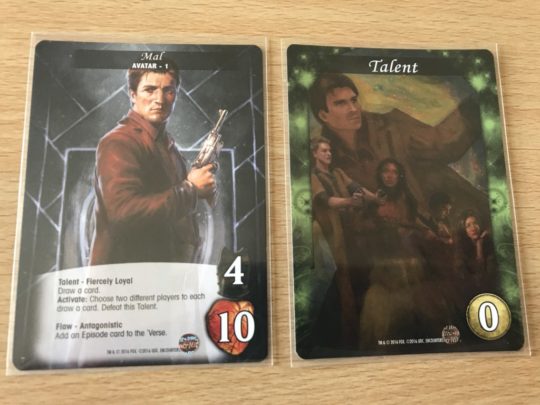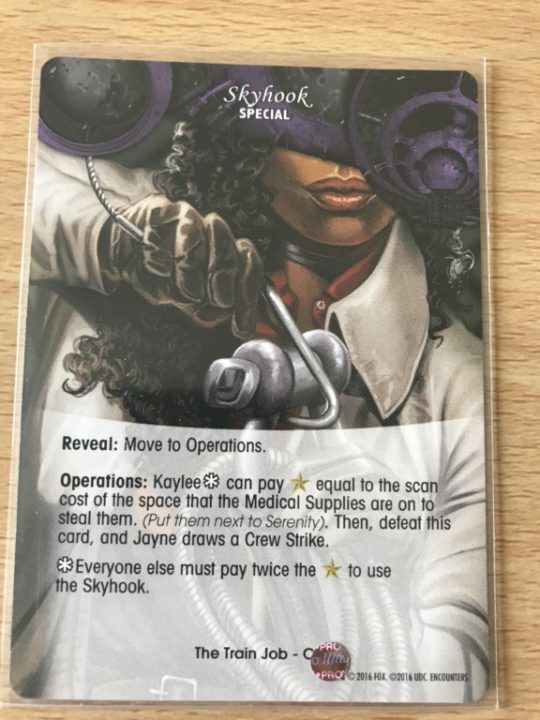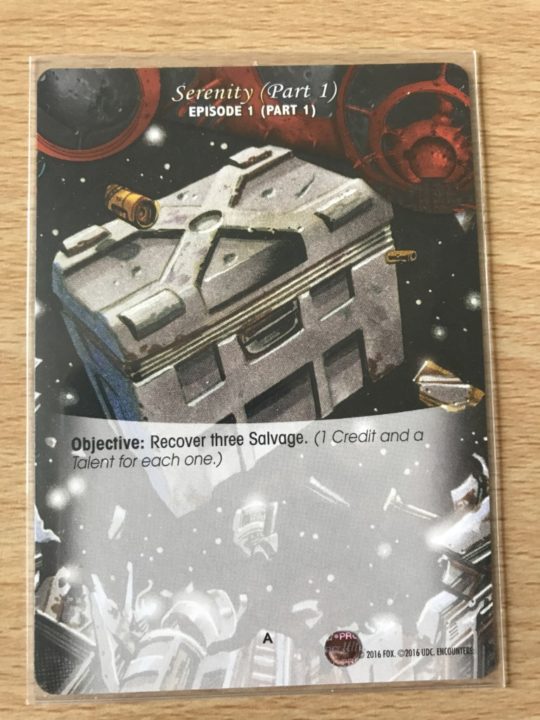Legendary Encounters: Firefly is a Co-Op Deck Building game.
Title: Legendary Encounters: Firefly
Year Published: 2016
Designer: Ben Cichoski, Daniel Mandel
Publisher: Upper Deck Entertainment
Players: 1-5
Game Time: 45-90 minutes
Set-up Time: ~5 minutes
Ages: 14+
Theme: Firefly ‘Verse
Mechanism: Co-op, Deck Building
How to win: Complete the Scenario
Game Description
A stand-alone game utilising the Legendary Encounters system set in the Firefly universe.
Legendary Encounters: Firefly Set Up
Players have a starting deck of 7 Shiny, 5 Misbehave and 1 Talent card.

Each player picks an Avatar as a main character. As the number of Main characters in every game is ALWAYS 5, add a number of Avatars under the Bridge to bring the total to 5.

Shuffle the cards belonging to the other 4 characters to make the crew deck.

Shuffle the Upgrades, Browncoats, Ship Strikes and Crew Strikes and put them on their spaces on the board. Put the Talent and Flaw cards face up near the board.
Pick objectives A, B & C from the chosen Episode cards and shuffle each related mini-deck under the card. Add Sidejobs (depending on the player count) and put the ‘Inevitable’ card for that set at the bottom of each stack.

Put 5 cards from the Crew deck on the Bridge.

Players shuffle their deck and draw 6 cards, the player who has the Highest Ranked Character goes first.
Legendary Encounters: Firefly Game Play
Each of these decks plays through an episode of the TV show with a turn split into 4 phases… Episode, Action, Strike and Cleanup
Episode Phase
The first thing you do is add the top card of the Episode deck to the ‘Verse face down, pushing any other cards to the left. If you push a card off to the left of the ‘Verse track it goes into the ‘Combat Zone’. Then you reveal it if it was face down and resolve any actions on the card if required.

Action Phase
Now you play cards from your hand and then resolve them immediately. These will give you some of two resources in the game, Recruit Points and Attack.

Cards also have abilities that activate when you play them but also some have class combo abilities. If you play a card with the same class as one played already, you can activate its extra ability.

Talents & Flaws
Talents and Flaws are cards that can be earned throughout the game.
Playing a Talent allows you to draw a card but if you decide to use its full potential then you can also activate the Talent on your Avatar. If you do, return the Talent card to the talent deck.

If you have a Flaw card in your hand you MUST play it and resolve the ‘Flaw’ effect on your Avatar. If you gain a Flaw card during your turn you MUST play, then return it to the Flaw stack.

Recruiting
Cards give you recruit points which you use to buy new cards. The cost of the card is in the bottom right and you can buy as many as cards as you can afford. When you take a card from the Crew deck row replace it immediately so you can see the next card before you keep spending. You can also recruit the top card of the Browncoat deck with purchased cards going into your discard pile.

You can scan a space on the ‘Verse by paying the cost shown in Attack Points under a face-down card to turn it face up.

What happens to a revealed card depends on the type of card…
Enemies
You defeat Enemies by spending attack power equal to their attack value and they go into the discard pile. Some have abilities that trigger when they are defeated. Any remaining attack power can be used to defeat additional enemies or even scan spaces.

Side Job
A Sidejob sits in the ‘Verse and moves along as normal. If you manage to complete the objective shown on the card, you gain the ‘Success’ text as a reward. Once a Sidejob is in the combat zone then it MUST be completed that turn. If it isn’t, you get the penalty listed in the ‘Failure’ text.

Events are simple. Once one is revealed you resolve its text and then discard it.

Ship Strikes do damage to Serenity. They are placed onto the lowest empty slot on the ship and you can pay the repair cost shown to remove the Strike from the ship.

Characters get shuffled into your deck…

if you play a Special card, they are resolved when revealed…

Goal cards show what you need to do to complete the current objective…

The Inevitable cards are placed at the bottom of a mini-deck face-up and move one space each turn. They represent the end of the chapter of the episode so you don’t really interact with them. If a card says to add cards to the ‘Verse then this card is moved instead and will push everything along as it goes.
Once it reaches the Combat Zone and once it has been through a Strike phase on each player’s turn any uncompleted objectives are failed.

Strike Phase
Enemies in the Combat Zone will strike…
For each Ship Enemy, one at a time, place a Ship strike on the lowest empty space of Serenity.
For each Crew Enemy, one at a time, place a crew strike near your Avatar. The attack value on the card is the amount of damage your character takes and some have abilities so you resolve them as the Strikes are drawn.

If you’re defeated (KO’d) you end your turn immediately. (you still draw all the Ship Strikes you would take) Turn your Avatar face down and shuffle your hand, deck and discard pile into a new deck.
You are effectively out of the game… However, if a player has the ability to heal a Strike and this brings you below the damage required to knock you out then you’re back in the game.
Cleanup Phase
Discard your hand and any cards played and draw 6 cards.
Check to see if you’ve completed all of the objectives on the episode card, if not play continues clockwise.

As soon as the objectives on the Episode card are complete then the episode ends. The active player goes straight to the cleanup phase. All cards from this episode, played or not, go into the defeated deck. The inevitable card is set aside and now you have an Intermission.
You only have these Intermissions after Episode 1 & 2 where you resolve ‘End of Episode’ effects and reveal the top 3 upgrade cards.

You work out how many credits you have to spend as a reward for completing the episode.
With these Credits, you can…
- Buy Ship upgrades by paying the cost and adding them to the highest slot on Serenity
- Repair Ship Strikes by paying the Credit cost next to the Strike and discarding it
- Heal Crew by paying the cost in Damage to remove a Damage card
- Draw cards by paying 2 Credits to have each player draw a card
Now setup Next Episode. Episode 2 starts with 2 cards already in the ‘Verse, Episode 3 starts with 4 cards!
Game End
If you eliminate all of the crew, you lose.
If Serenity is full of Strike cards and takes one more, she blows up and you lose.
Also, if you fail the mandatory objectives of a Goal, you lose.
But, if in Episode 3 you have completed all of the Mandatory objectives you win the game!
Episode 3 contains some text on what to do in the next scenario, but if you’re not playing a Campaign then ignore it.

Round-Up
My favourite mechanism is Deck Building.
My favourite deck-building system in Legendary Encounters.
Also, my Second favourite IP ever is Firefly with my favourite being Buffy the Vampire Slayer.
So Legendary Encounters: Firefly is not a bad combination for me with not much else to say really. 🙂
Playing through the Episodes is great and the cards really sell the theme of the episode you’re in.
The 5 crew that you pick will affect how the game plays. It means you can’t just play with your fave 4 sets of cards (I used to do this in Marvel Legendary) and buy the same ones every game. You need to move some of those characters into your main crew so the game doesn’t kill you.
Most people complain about the art in Legendary Encounters: Firefly and claim the game is borderline unplayable because of it but I really don’t care… It’s not the best art of course but it’s not offensive at all and so doesn’t affect the game for me.
Legendary Encounters: Firefly Rating
A fantastic deck-building game system with a great IP attached.
I give it 9/10


Leave a Reply